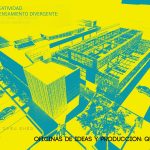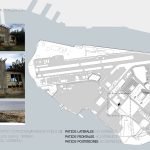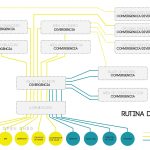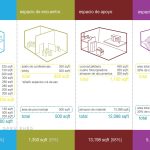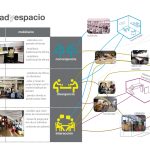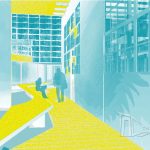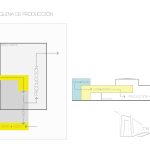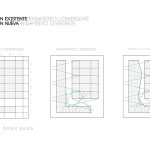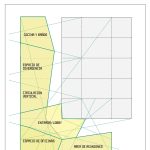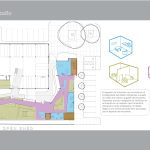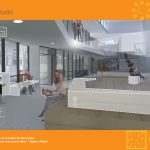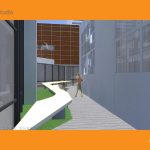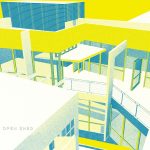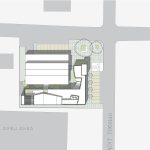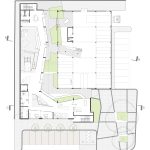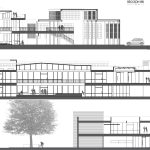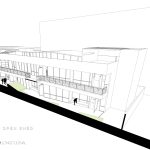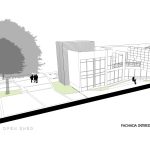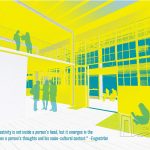Creativity and Divergent Thinking:
Spaces to stimulate the creative process
“It is by breaking with the usual parameters of work space that we can create an unusual environment and so provide the possibility to come up with creative solutions”. – Alonso, L.
Designer: Luis E. Alonso Conty
Thesis Director: Humberto Cavalín
Project Date: UPR May, 2013
TOS[er]: Luis Y. Negrón Rivera
Posted Date: December, 2013
Coming up with a creative idea is not an easy task, even for those involved in creative production and innovation. Luis Alonso’s thesis charts the nature of creativity, and its relation with the constructed environment, in order to stimulate it through concerted spatial design strategies. This approach is essential particularly in workspace environments. The thesis proposal focuses on this kind of space where production depends on the employees’ everyday creativity. Given that creativity is a very complex phenomenon – that depends on the particular formation of each individual – there is no guaranty that these spatial design strategies will instigate everyone’s creativity equally. Still, by understanding the psychosocial behavior of people combined with the associative mechanisms of the mind – that constantly reacts to an individual’s surroundings and activities – it is possible to establish the conditions for creative thinking by promoting, and controlling, certain activities through architecture. Decisions like, where to position work surfaces, which is the best orientation/view, when should it be an individual and/or collective work space, and, how close is the seating, influence the way people inhabit the space and interact with each other. In Alonso’s words, “there are few factors that can be altered to influence an individual’s creativity and environmental design is the most related to the individual’s everyday-life”.
In his research about the theories of creativity, Alonso emphasizes the cognitive theory of divergent/lateral thinking versus convergent/logical thinking applied to problem solving situations. Divergent thinking – the focus of his thesis – is described as “the process when ideas and their associations move in different directions, resulting in new and original ideas.” Convergent thinking is the opposite. It “identifies the correct or conventional idea.” The lateral thinking is ideal for problems without a constraining structure; problems that embrace infinite possible ways of being solved. It allows for the combination of ideas, or even, layers of information, that don’t seem to be linked, because such associations require higher levels of abstraction. The concept of divergent/lateral thinking also establishes that the production of creative ideas/solutions come from the individual’s knowledge of the problem – anchored in research and analysis of factors that may influence them – instead of intuition and inspiration alone.
By combining these 2 thinking methods – convergent and divergent – it is possible to generate an idea that is both effective and original. It is for this reason that the most innovative work spaces in the creative production industry provide environments for reflection/analysis of the problem, as well as, other spaces for stimulating divergent thinking through collective interaction and brainstorming.
As case studies, Alonso selected Pixar Studios HQ in Emeryville, California (1999), Facebook Offices in Palo Alto, California (2009), and, Google Offices in Zurich, Switzerland (2007). Each of them represents a state-of-the-art company of the creative production industry. All 3 appeal to similar spatial distribution and design strategies.
Alonso identified 4 common spatial categories:
- home base
- transitional space
- meeting areas
- creative support & service facilities
The home base, or office, is isolated and private making it easier to concentrate and analyze the problem. The other spatial categories encourage encounter and social interaction. The first stimulates, mostly but not only, the convergent/logical thinking; while the rest incite divergent thinking. Transitional spaces, like entranceways and hallways, allow for less formal and sporadic encounters depending on their location. Meeting spaces – the incubators for lateral thinking – are specifically intended for sharing ideas collectively. They work like pockets attached to the transitional spaces, and, in some cases, they are linked to home base modules. Likewise, support/service spaces – cafeterias, play rooms, etc. – provide the conditions for collective interaction and activate divergent thinking, precisely by distracting the mind from the problem. Sometimes ingenious solutions come when we less expect them; having a casual conversation at a bar or sharing ideas with a colleague in a ping pong game serve as fertile ground for brainstorming. Other factors, like furniture, surface orientation, as well as, density and activity level, determine such conditions.
To demonstrate his thesis Alonso selects an industrial site owned by the government near the Convention District in San Juan port area. The site has an abandoned factory building and is ideal for the proposed intervention. The program includes a new building for creative production of design and related administrative purposes. The existing building accommodates a design-build workshop and storage. Alonso completes several analytical diagrams of the program requirements and employee relationships. His conceptual approach is to transform the existing axial rhythms of the old factory and establish a new flexible grid. The resulting geometry of this grid system accommodates for the more playful spaces that promote divergent thinking. It also adds complexity and character to the new building.
The most memorable event of the interior experience is the atrium next to the main entrance. It is inhabited by a sculptural stairway/platform and a bridge, across an interstitial garden, that links the new building (creative idea production) with the existing one (mock-up fabrication). Transitional and meeting spaces overlap in the atrium’s gathering space allowing for greater flexibility and use of the space. Alonso exploits the possibilities of unconventional furniture and accessories by including a bar (for informal conversations), a mezzanine-level billiard table (to stimulate peer collaboration/feedback), and, by projecting images on strategic walls (for collective presentations, brainstorming and recreational media). The atrium is supported on one end by a kitchenette and, on the other, by offices and conference rooms. In addition, secondary meeting areas and terraces offer more relaxing, yet eccentric, environments to stimulate/enhance constant peer feedback. The spatial diversity works in tandem with customized furniture that offer flexible configurations to adjust to spontaneous and particular needs and desires.
Alonso’s design decisions, from the overall building layout down to the furniture detailing, are guided by the conviction that “being social in the work environment is crucial for being creative”.
TOS[er] reaction: Why can’t work be fun? Won’t employees work with more commitment and enthusiasm? The strategies that Luis Alonso uses in his project demonstrate that one can be creative without losing control of the design. The result: a fun and feasible building to work in. For those of us who work or intend to dedicate our professional career to the design industry, the essence of this thesis is fundamental, not only to understand how the environment stimulates creativity for future design generations, but also, to be constantly critical and proactive about our own work environments.

